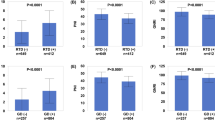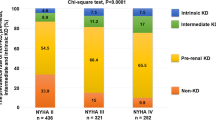Abstract
Background
Renal tubular damage (RTD) and hypoalbuminemia are risks for poor prognosis in patients with chronic heart failure (CHF). Renal tubules play a pivotal role in amino acid and albumin reabsorption, which maintain serum albumin levels. The aims of the present study were to (1) examine the association of RTD with hypoalbuminemia, and (2) assess the prognostic importance of comorbid RTD and hypoalbuminemia in patients with CHF.
Methods and results
We measured N-acetyl-β-D-glucosamidase (NAG) levels and the urinary β2-microglobulin to creatinine ratio (UBCR) in 456 patients with CHF. RTD was defined as UBCR ≥300 μg/g or NAG ≥14.2 U/g. There were moderate correlations between RTD markers and serum albumin (NAG, r = −0.428, P < 0.0001; UBCR, r = −0.399, P < 0.0001). Multivariate logistic analysis showed that RTD was significantly related to hypoalbuminemia in patients with CHF. There were 134 cardiac events during a median period of 808 days. The comorbidity of RTD and hypoalbuminemia was increased with advancing New York Heart Association functional class. Multivariate Cox proportional hazard regression analysis showed that the presence of RTD and hypoalbuminemia was associated with cardiac events. The net reclassification index was significantly improved by adding RTD and hypoalbuminemia to the basic risk factors.
Conclusion
Comorbid RTD and hypoalbuminemia are frequently observed and increase the risk for extremely poor outcome in patients with CHF.





Similar content being viewed by others
References
Lloyd-Jones DM, Larson MG, Leip EP, Beiser A, D’Agostino RB, Kannel WB, Murabito JM, Vasan RS, Benjamin EJ, Levy D (2002) Lifetime risk for developing congestive heart failure: the Framingham Heart Study. Circulation 106(24):3068–3072
Ohlmeier C, Mikolajczyk R, Frick J, Prutz F, Haverkamp W, Garbe E (2015) Incidence, prevalence and 1-year all-cause mortality of heart failure in Germany: a study based on electronic healthcare data of more than six million persons. Clin Res Cardiol. doi:10.1007/s00392-015-0841-4
Meinertz T, Diegeler A, Stiller B, Fleck E, Heinemann MK, Schmaltz AA, Vestweber M, Bestehorn K, Beckmann A, Hamm C, Cremer J (2015) German Heart Report 2013. Clin Res Cardiol 104(2):112–123. doi:10.1007/s00392-014-0799-7
Uthamalingam S, Kandala J, Daley M, Patvardhan E, Capodilupo R, Moore SA, Januzzi JL Jr (2010) Serum albumin and mortality in acutely decompensated heart failure. Am Heart J 160(6):1149–1155. doi:10.1016/j.ahj.2010.09.004
Gopal DM, Kalogeropoulos AP, Georgiopoulou VV, Tang WW, Methvin A, Smith AL, Bauer DC, Newman AB, Kim L, Harris TB, Kritchevsky SB, Butler J (2010) Serum albumin concentration and heart failure risk The Health, Aging, and Body Composition Study. Am Heart J 160(2):279–285. doi:10.1016/j.ahj.2010.05.022
Bonilla-Palomas JL, Gamez-Lopez AL, Moreno-Conde M, Lopez-Ibanez MC, Anguita-Sanchez M, Gallego de la Sacristana A, Garcia-Catalan F, Villar-Raez A (2014) Hypoalbuminaemia in acute heart failure patients: causes and its impact on hospital and long-term mortality. J Card Fail. doi:10.1016/j.cardfail.2014.01.016
Liu M, Chan CP, Yan BP, Zhang Q, Lam YY, Li RJ, Sanderson JE, Coats AJ, Sun JP, Yip GW, Yu CM (2012) Albumin levels predict survival in patients with heart failure and preserved ejection fraction. Eur J Heart Fail 14(1):39–44. doi:10.1093/eurjhf/hfr154
Harnett JD, Foley RN, Kent GM, Barre PE, Murray D, Parfrey PS (1995) Congestive heart failure in dialysis patients: prevalence, incidence, prognosis and risk factors. Kidney Int 47(3):884–890
Goh CY, Vizzi G, De Cal M, Ronco C (2011) Cardiorenal syndrome: a complex series of combined heart/kidney disorders. Contrib Nephrol 174:33–45. doi:10.1159/000329233
Ronco C, Haapio M, House AA, Anavekar N, Bellomo R (2008) Cardiorenal syndrome. J Am Coll Cardiol 52(19):1527–1539. doi:10.1016/j.jacc.2008.07.051
Otaki Y, Watanabe T, Takahashi H, Narumi T, Kadowaki S, Honda Y, Arimoto T, Shishido T, Miyamoto T, Konta T, Kubota I (2014) Association of renal tubular damage with cardio-renal anemia syndrome in patients with heart failure. Int J Cardiol 173(2):222–228. doi:10.1016/j.ijcard.2014.02.044
Schmieder RE, Mitrovic V, Hengstenberg C (2015) Renal impairment and worsening of renal function in acute heart failure: can new therapies help? The potential role of serelaxin. Clin Res Cardiol. doi:10.1007/s00392-015-0839-y
Damman K, Van Veldhuisen DJ, Navis G, Vaidya VS, Smilde TD, Westenbrink BD, Bonventre JV, Voors AA, Hillege HL (2010) Tubular damage in chronic systolic heart failure is associated with reduced survival independent of glomerular filtration rate. Heart 96(16):1297–1302. doi:10.1136/hrt.2010.194878
Otaki Y, Watanabe T, Shishido T, Takahashi H, Funayama A, Narumi T, Kadowaki S, Hasegawa H, Honda S, Netsu S, Ishino M, Arimoto T, Miyashita T, Miyamoto T, Konta T, Kubota I (2013) The impact of renal tubular damage, as assessed by urinary beta2-microglobulin-creatinine ratio, on cardiac prognosis in patients with chronic heart failure. Circ Heart Fail. doi:10.1161/circheartfailure.112.000089
Nakhoul N, Batuman V (2011) Role of proximal tubules in the pathogenesis of kidney disease. Contrib Nephrol 169:37–50. doi:10.1159/000313944
Tojo A, Kinugasa S (2012) Mechanisms of glomerular albumin filtration and tubular reabsorption. Int J Nephrol 2012:481520. doi:10.1155/2012/481520
Tojo A (2013) The role of the kidney in protein metabolism: the capacity of tubular lysosomal proteolysis in nephrotic syndrome. Kidney Int 84(5):861–863. doi:10.1038/ki.2013.284
McKee PA, Castelli WP, McNamara PM, Kannel WB (1971) The natural history of congestive heart failure: the Framingham study. N Engl J Med 285(26):1441–1446. doi:10.1056/nejm197112232852601
Eckardt KU, Berns JS, Rocco MV, Kasiske BL (2009) Definition and classification of CKD: the debate should be about patient prognosis—a position statement from KDOQI and KDIGO. Am J Kidney Dis 53(6):915–920. doi:10.1053/j.ajkd.2009.04.001
National Kidney Foundation (2002) K/DOQI clinical practice guidelines for chronic kidney disease: evaluation, classification, and stratification. Am J Kidney Dis 39(2 Suppl 1):S1–266
Otaki Y, Watanabe T, Takahashi H, Hirayama A, Narumi T, Kadowaki S, Honda Y, Arimoto T, Shishido T, Miyamoto T, Konta T, Shibata Y, Fukao A, Daimon M, Ueno Y, Kato T, Kayama T, Kubota I (2014) Association of heart-type fatty acid-binding protein with cardiovascular risk factors and all-cause mortality in the general population: the Takahata study. PLoS One 9(5):e94834. doi:10.1371/journal.pone.0094834
Otaki Y, Takahashi H, Watanabe T, Kadowaki S, Narumi T, Honda Y, Hasegawa H, Honda S, Funayama A, Nishiyama S, Arimoto T, Shishido T, Miyashita T, Miyamoto T, Kubota I (2014) Electrocardiographic left ventricular hypertrophy Cornell product is a feasible predictor of cardiac prognosis in patients with chronic heart failure. Clin Res Cardiol 103(4):275–284. doi:10.1007/s00392-013-0646-2
Konta T, Kudo K, Sato H, Ichikawa K, Ikeda A, Suzuki K, Hirayama A, Shibata Y, Watanabe T, Daimon M, Kato T, Ueno Y, Kayama T, Kubota I (2013) Albuminuria is an independent predictor of all-cause and cardiovascular mortality in the Japanese population: the Takahata study. Clin Exp Nephrol 17(6):805–810. doi:10.1007/s10157-013-0770-3
Valdespino-Trejo A, Orea-Tejeda A, Castillo-Martinez L, Keirns-Davis C, Montanez-Orozco A, Ortiz-Suarez G, Delgado-Perez DA, Marquez-Zepeda B (2013) Low albumin levels and high impedance ratio as risk factors for worsening kidney function during hospitalization of decompensated heart failure patients. Exp Clin Cardiol 18(2):113–117
Castillo-Martinez L, Colin-Ramirez E, Orea-Tejeda A, Gonzalez Islas DG, Rodriguez Garcia WD, Santillan Diaz C, Gutierrez Rodriguez AE, Vazquez Duran M, Keirns Davies C (2012) Cachexia assessed by bioimpedance vector analysis as a prognostic indicator in chronic stable heart failure patients. Nutrition 28(9):886–891. doi:10.1016/j.nut.2011.11.024
Arques S, Ambrosi P, Gelisse R, Luccioni R, Habib G (2003) Hypoalbuminemia in elderly patients with acute diastolic heart failure. J Am Coll Cardiol 42(4):712–716
Martinez-Santos P, Vilacosta I (2011) Cardiorenal syndrome: an unsolved clinical problem. Int J Nephrol 2011:913029. doi:10.4061/2011/913029
McAlister FA, Ezekowitz J, Tonelli M, Armstrong PW (2004) Renal insufficiency and heart failure: prognostic and therapeutic implications from a prospective cohort study. Circulation 109(8):1004–1009. doi:10.1161/01.cir.0000116764.53225.a9
Mahon NG, Blackstone EH, Francis GS, Starling RC 3rd, Young JB, Lauer MS (2002) The prognostic value of estimated creatinine clearance alongside functional capacity in ambulatory patients with chronic congestive heart failure. J Am Coll Cardiol 40(6):1106–1113
Keller C, Katz R, Sarnak MJ, Fried LF, Kestenbaum B, Cushman M, Shlipak MG (2010) Inflammatory biomarkers and decline in kidney function in the elderly: the Cardiovascular Health Study. Nephrol Dial Transplant 25(1):119–124. doi:10.1093/ndt/gfp429
Kudo K, Konta T, Mashima Y, Ichikawa K, Takasaki S, Ikeda A, Hoshikawa M, Suzuki K, Shibata Y, Watanabe T, Kato T, Kawata S, Kubota I (2011) The association between renal tubular damage and rapid renal deterioration in the Japanese population: the Takahata study. Clin Exp Nephrol 15(2):235–241. doi:10.1007/s10157-010-0392-y
Nangaku M (2006) Chronic hypoxia and tubulointerstitial injury: a final common pathway to end-stage renal failure. J Am Soc Nephrol 17(1):17–25. doi:10.1681/asn.2005070757
Damman K, Masson S, Hillege HL, Voors AA, van Veldhuisen DJ, Rossignol P, Proietti G, Barbuzzi S, Nicolosi GL, Tavazzi L, Maggioni AP, Latini R (2013) Tubular damage and worsening renal function in chronic heart failure. JACC Heart Fail 1(5):417–424. doi:10.1016/j.jchf.2013.05.007
Shiba N, Shimokawa H (2008) Chronic heart failure in Japan: implications of the CHART studies. Vasc Health Risk Manag 4(1):103–113
Shiba N, Nochioka K, Miura M, Kohno H, Shimokawa H (2011) Trend of westernization of etiology and clinical characteristics of heart failure patients in Japan—first report from the CHART-2 study. Circ J 75(4):823–833
von Scheidt W, Zugck C, Pauschinger M, Hambrecht R, Bruder O, Hartmann A, Rauchhaus M, Zahn R, Brachmann J, Tebbe U, Neumann T, Strasser RH, Bohm M, Stork S, Hochadel M, Heidemann P, Senges J (2014) Characteristics, management modalities and outcome in chronic systolic heart failure patients treated in tertiary care centers: results from the EVIdence based TreAtment in Heart Failure (EVITA-HF) registry. Clin Res Cardiol 103(12):1006–1014. doi:10.1007/s00392-014-0743-x
Acknowledgments
This study was supported, in part, by a grant-in-aid for Scientific Research (No. 26893025) from the Ministry of Education Culture, Sport, Science and Technology and a grant-in-aid from the global century center of excellence (COE) program of the Japan Society for the Promotion of Science.
Author information
Authors and Affiliations
Corresponding author
Ethics declarations
Conflict of interest
None.
Rights and permissions
About this article
Cite this article
Otaki, Y., Watanabe, T., Takahashi, H. et al. Comorbid renal tubular damage and hypoalbuminemia exacerbate cardiac prognosis in patients with chronic heart failure. Clin Res Cardiol 105, 162–171 (2016). https://doi.org/10.1007/s00392-015-0899-z
Received:
Accepted:
Published:
Issue Date:
DOI: https://doi.org/10.1007/s00392-015-0899-z




